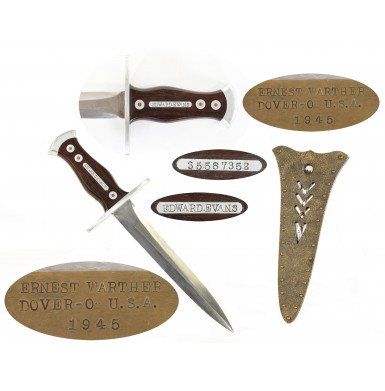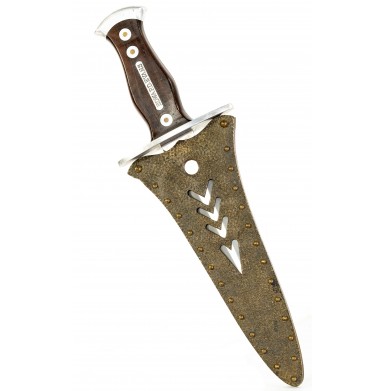Ernest “Mooney” Warther was born on October 30, 1885, the son of Swiss emigrants to had relocated to the United States in 1881. The family settled in the Dover (Tuscarawas County) area of Ohio. Ernest’s father Godfrey passed away in 1888 when Mooney was 3 and all of the family had to work hard to survive. As a child Mooney tended the family cow and did similar work for neighbors to earn a small amount of money. In fact, his lifelong nickname came from that work, a corruption of the Swiss word “moonae” which meant “bull of the herd.” At the age of 5 Mooney found a pocketknife and started to whittle and carve to pass the time while tending the cows. This evolved into a lifelong passion and earned him the title of the “world’s master carver”. By the age of 14 Mooney was working the American Sheet and Tin Plate Mill in Dover to earn more money and to help support the family. He had also started to experiment with making knives as he was unhappy that commercially available knives would not hold the edge he required for his detailed carving. In 1902, at the age of 17, he presented his mother with a kitchen knife that he had made, and this was the beginning of a family cutlery business that remains in business to this day, some four generations later.
Mooney’s carving ability came to national attention during first half of the 1910s. He had learned to carve a functional set of pliers from a piece of wood with only 10 cuts. In 1913, he took this to highest level by carving a large block of walnut into 511 sets of interlocking functional pliers, a feat that took 64-hours and more than 31,000 cuts. The amazing part was that when the pliers were all folded closed the Plier Tree returned to its original block of wood shape! His amazing work of functional art was display at the 1933-34 Chicago World’s Fair, where Warther amazed even Robert Ripley of Ripley’s Believe it or Not! fame. The quality of his carving was so impressive that President Warren G Harding had him carve “A History of Trains”, a subject matter that Warther was particularly interested in. His carvings were so detailed and complicated that the trains were fully functional, with moving wheels and pistons! His work was so impressive that Henry Ford offered him $75,000 for a number of his carvings and offered to pay Warther $5,000 a year (a princely sum at the time) to come and carve full time at the new Ford Museum in Dearborn, MI. Mooney declined. However, in 1936 Mooney opened his own small museum in Dover to display his carvings. That museum has expanded over the decades and remains a major Ohio tourist attraction to this day.
By 1923 Mooney had left the steel mill and was making kitchen knives full time, which supported his family and his love of carving which he had developed to an incredible art form. His knives were of exceptional quality, not only because of his attention to detail but because of his painstaking work to find the best ways to temper and handle the steel to make it perfect for his purposes, a strong blade that held a razor-sharp edge. With the coming of World War II Mooney sought to contribute to the war effort by producing fighting knives for American servicemen. The knife he designed and produced the most of was a heavy-duty fighting dagger that was nominally 12” in overall length with a full-tang blade that was nominally 7.75” in length, slightly more than 1” wide at the ricasso and with a double-edged dagger profile with a prominent median ridge. The knife was mounted with aluminum bolsters, flared aluminum pommel cap and a nominally 4” oval aluminum guard. The ebony scales were secured with three brass pins with aluminum escutcheons. Sometimes other material was used as well, but Mooney's preference for ebony for his carving projects (along with ivory) made it a common wood for him to use and one that was readily available in his shop. The scales had oval aluminum panels on both sides into which Mooney stamped the name and service number of the man who he made the knife for. The knives were contained in wicked looking metal scabbards that are so futuristic in appearance for the times that they seem more akin to something you would see a Klingon or Romulan wearing in the original Star Trek series! These two-piece scabbards were made from textured aluminum front pieces with decorative holes in the face that also allowed water to escape, and polished sheet steel rears with a jeweled finish. The scabbards were pinned with together with brass pins and leather or fiber spacers were used to separate the front and rear sections. A heavy-duty brass belt loop on the rear allowed the scabbard to be attached to a belt and was marked to let everyone know it was the work of Ernest Warther of Dover, OH. The front of the scabbards were painted with an olive drab paint with speckles of gold color. Ernest would only make the fighting knives for servicemen and for nobody else. While Cole does not provide any production numbers, he notes that Mooney “devoted many long hours” to making knives throughout the war. Bill Walters places Warther’s output at about 1,100 knives.
After the war Ernest returned to more traditional knife making and to his exquisite carvings. His sons became part of the business and helped to grow it and allowed Mooney to spend more time with his hobby. In 1963 Mooney and his sons expanded his museum substantially and his craving museum can still be visited today. Mooney had a stroke in 1971 which ended his carving career and died on June 6, 1973. Today militaria collectors remember him for his exquisite fighting knives and his contribution to the World War II war effort, but that was only a tiny part of Ernest Mooney’s story and life.
The Warther Fighting Knife offered here is in about EXCELLENT condition and is a truly impressive piece of knife making. It conforms to the typical Warther knife with a full-length tang dagger blade that is 7 7/8” in length with an overall length of 12 1/8”. The knife fits the hand perfectly and is incredibly well balanced. The obverse grip scale has the name Edward Evans stamped in the oval escutcheon plate and Evans’ service number 35587352 is stamped in the reverse escutcheon plate. The rear of the scabbard’s brass belt loop is stamped in three lines:
ERNEST WARTHER
DOVER-O U.S.A.
1945
As noted, the knife remains EXCELLENT condition. The blade retains most of the original polish with only some lightly scattered minor surface oxidation and age discoloration, most of which is around the ricasso and guard area. There is also some scattered oxidation along the tang, between the scales and some minor discoloration on the aluminum fittings. The scabbard is in equally wonderful condition with nearly all of the front paint intact and the rear still showing the hand applied jeweled pattern. All markings in the grip and on the belt loop are clearly and crisply stamped.
Edward Evans (1922-2003) was a 19-year-old “semi-skilled welder and flame cutter” from Mahoning County when he enlisted in the US Army on October 22, 1942. The limited service records I could locate indicated that he as a Warrant Officer and probably worked as some form of combat engineer during the war. After the war the 1950 Census listed him as a “Steel Mill Electrician”. Evans died in 2003 at the age of 80, six days short of his 81st birthday. Further research about Evans could prove fruitful.
Overall, this is a really wonderful example of a scarce, very impressive, and very high condition Warther Fighting Knife. These do not appear on the market very often and this would be an excellent addition to any serious collection of World War II fighting knives.
SOLD










